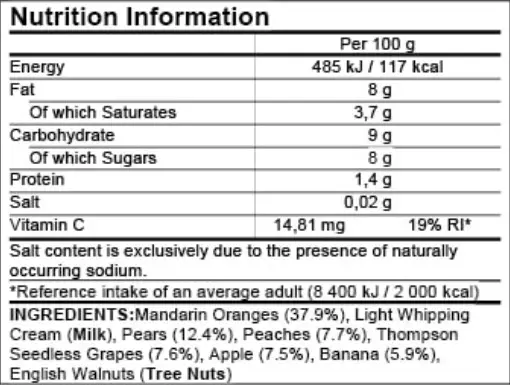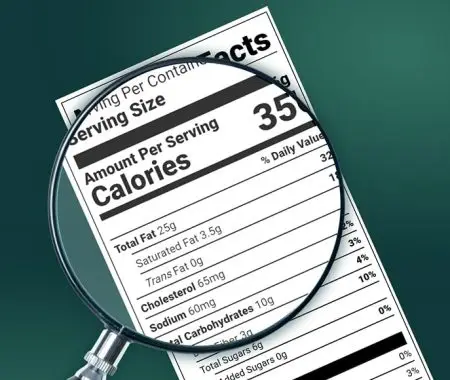Navigating the complexities of food labeling regulations within the European Union (EU) is crucial for any entity involved in the food industry. In response to this, The European Commission (EC) has released compulsory regulations for nutritional information on food labels that are designed to promote informed dietary choices.
This article provides an overview of the current regulations, highlighting what manufacturers must include on their labels to remain compliant with the food labelling regulations 2020. Understanding these requirements is essential for legal standards but also fosters a sense of trust and transparency with consumers.
TLDR
- EU Food Labeling Regulations: All packaged food products sold in the EU must display detailed nutritional information (highlighting allergens in particular), the net quantity of the product, the best before or use by date, and any nutritional claims (must be based on scientific evidence).
- Ingredients and Allergens: Ingredients must be listed in descending order of weight. Allergens from the EC’s recognized list of 14 must be highlighted on the label to ensure consumer safety.
- Dates and Quantities: Labels must display ‘best before’ or ‘use by’ dates to communicate product freshness and safety. The net quantity of the food must also be stated in metric units (grams, kilograms, milliliters, or liters).
- Fair Information Practices: EC standards ensure label transparency to prevent misleading information, protect consumer rights, and promote ethical consumerism. This ensures fair competition among companies by requiring them all to adhere to the same labeling standards.
- Legal Consequences of Non-Compliance: Failure to comply with these standards can result in fines, product recalls, or bans, which could financially and reputationally damage a business. Companies must regularly update and review their labels to ensure compliance.
- Mandatory Nutritional Components: Labels must include detailed mandatory nutritional information to facilitate informed consumer choices and promote healthier lifestyles.
- Voluntary Additions: Adding voluntary nutritional information such as vitamin and mineral content can provide competitive advantages by appealing to health-conscious consumers.
- Technology for Compliance: Companies like Food Label Maker help businesses ensure their labels are compliant with regulations by automating the creation and updating of nutrition labels.
Understanding the Basics
Under the current EU regulations, several elements must be displayed on packaged food products according to European Commission standards. These include:
- Nutritional Information: This encompasses the energy value in both kilojoules and kilocalories, along with the amounts of fat, saturates, carbohydrates, sugars, protein, and salt per 100g or 100ml. It is also mandatory to provide this information per portion or consumption unit, as applicable.
- List of Ingredients: All ingredients must be listed in descending order of weight as they appear in the product.
- Allergen Highlighting: Any of the 14 recognized allergens, when present, must be clearly highlighted in the ingredient list.
- Net Quantity: The net quantity of the food must be stated in metric units (grams, kilograms, milliliters, or liters).
- Best Before or Use By Date: Products must clearly display their ‘best before’ or ‘use by’ date to ensure consumers are aware of the safety and quality of the food and when it can be eaten by.
- Nutrition Claims: Any nutrition or health claims made on the packaging must be in line with the current EC regulations and be backed up by scientific research.

These mandatory food labeling rules serve two purposes: promoting consumer safety and encouraging more informed nutrition choices. Nutrition facts labels need to have comprehensive nutritional information about what ingredients are found in food products. This helps consumers manage their dietary needs and preferences more effectively. The regulations also standardize food information across the EU so that all consumers have access to the same quality of information.
See How FoodLabelMaker Can Help You
Fair Information Practices in Food Labelling
The European Commission sets strict ethical and legal standards on their food labels. They aim to provide transparency regarding what is contained in food products and prevent any misleading information from being on food labels. Consumers are then aware of any “unhealthy” nutrients in their food which allows them to avoid any foods that contain any nutrients that could harm them or cause long-term health issues.
The Ethical Grounds of Food Labelling
Fair information practices in food labelling are critical for protecting consumers. Labels need to have accurate information that is easy for them to understand. This, as we have said, empowers consumers to make more informed decisions when it comes to their health and diet. This transparency supports ethical consumerism and creates a stronger bond with consumers in return.
Additionally, these practices contribute to fair competition in the market as all companies are forced to follow the same standards and rules. It also helps prevent any business from manipulating their labeling or not disclosing certain information so that they appear more desirable to a consumer, ultimately giving them an unfair advantage over their competitors.
Legal Implications for Non-Compliance
If your labels do not comply with these EC standards, your business might face significant penalties. This includes fines product recalls, or even bans from selling in particular countries or within certain parameters. These penalties affect your business financially by not being able to sell your product anymore and can also damage your reputation. This could mean that your customer base no longer trusts your brand or the reliability of your product, further leading to a long-term decline in sales or customer retention.
To avoid these penalties, businesses have to stay updated with the latest labeling regulations and implement regular reviews of their product labels to make sure that they are compliant. An idea might be to employ experts or legal advisors to check that your labels meet all the standards that are required.
Mandatory Particulars in Food Labelling
For businesses to ensure that they comply with EC standards, their food labels must include specific features that go beyond basic nutritional information. These mandatory elements provide consumers with comprehensive details about the food products they consume. These include:
Ingredients Lists and Allergens
The listing of ingredients and allergens on food labels must adhere to specific EC requirements:
- Ingredients List: Ingredients must be listed in descending order of weight as they were used in the preparation of the product. This list must be clear and understandable, and use the ingredient’s common name.
- Allergens: EC regulations require that allergens be highlighted within the ingredient list. Common allergens like nuts, gluten, dairy, and shellfish must be distinguished from other ingredients through formatting like bold text, underlining, or a different colored text. This is crucial in helping consumers with allergies easily identify potentially harmful ingredients.
Best Before and Expiry Dates
Correctly displaying best before and expiry dates is another critical component of EC food labeling:
- Best Before Date: This date indicates when a food product retains its intended quality under the necessary storage conditions. It must be clearly formatted as “Best before (date)” or “Best before end (date)”.
- Expiry Date: This date is used less frequently but is still crucial for food safety. It indicates the last date a product is considered safe to consume. It should be clearly marked as “Use by (date)” or To be consumed by (date)”.
Both dates must be easy to find, easy to read, and printed in a format that prevents them from being easily removed. Properly displaying these dates not only complies with EC regulations but also helps stay in line with what consumers expect regarding a product being fresh and safe to eat.
Understanding these requirements is essential for food businesses to ensure their products meet EC standards. It also means that they avoid potential legal issues while maintaining trust and confidence with their customers.
Nutrition Declaration Nuances
Navigating the landscape of nutrition declarations is crucial for compliance and market appeal. Understanding both the mandatory requirements and voluntary information can significantly impact your product’s impact in the industry.
Mandatory Nutritional Components
EU regulations stipulate that certain nutritional elements must always be displayed on food product labels. These mandatory elements include:
- Energy Value: Must be expressed in both kilojoules (kJ) and kilocalories (kcal), providing a clear measure of the energy content per 100 grams or milliliters.
- Fat, Saturates, Carbohydrates, Sugars, Protein, and Salt: These must also be quantified per 100 grams or milliliters. This standardization helps consumers easily compare products.
- Presentation: The nutritional information should be presented in a tabular format with the numbers aligned if space permits. If not, the information should be in a linear format.
This mandatory disclosure ensures that all food products provide a consistent level of information, enabling consumers to make informed dietary choices based on universally understood metrics.
Voluntary Additions and Their Benefits
While the basics cover mandatory information, adding voluntary nutritional details can enhance a product’s appeal and competitive edge, particularly in new markets:
- Additional Nutrients: Including vitamins and minerals can appeal to health-conscious consumers. For instance, noting the presence of vitamins D and calcium can attract those interested in bone health.
- Health Claims: Any voluntary addition should align with approved health claims. For example, if a product is high in omega-3 fatty acids, stating this can attract consumers interested in cardiovascular health.
- Localization: Tailoring nutritional information to meet local dietary concerns or preferences can also enhance market penetration.
Even though they are not mandatory, these voluntary disclosures can significantly influence consumer purchasing decisions, particularly among those who have specific dietary goals or health concerns. By strategically presenting this information, while still following regulatory standards, manufacturers can position their products as the preferred choice for more health-aware consumers.
Leveraging Technology for Compliance
In today’s food and beverage industry, making sure that your food labels are compliant with current regulations is crucial. At times, it can be difficult to know what standards you need to apply to your labels, or whether your nutrition facts labels are compliant with the updated regulations. This is why technological solutions like those offered by Food Label Maker can help make this process easier and more efficient. Their platform automates the creation of nutrition labels and ensures that all mandatory nutritional information such as calories, fats, sugars, and other nutrients are accurately calculated and displayed.
By using advanced tools and platforms like this, it takes the pressure off of food manufacturers regarding compliance. It also quickens businesses’ operations, reduces the risk of human errors, and eliminates the need to constantly double-check your labels. This means that businesses can focus on innovating their products and growing in the market.



